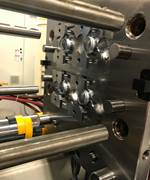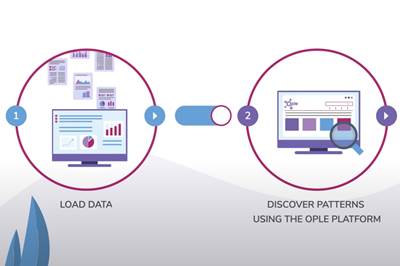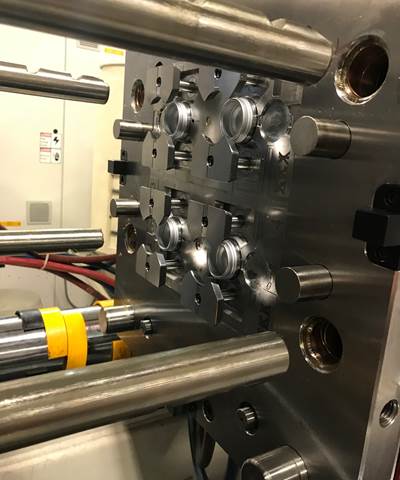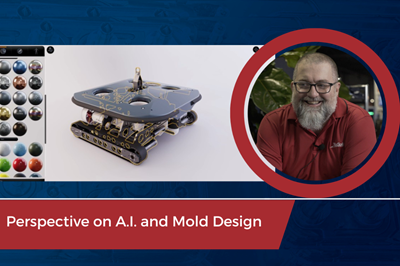Using AI to Transform Part and Mold Manufacturing
A Michigan startup is leveraging AI-designed molds in a bid to “commoditize” tool building and optimize parts in the process.

Atomic Industries is leveraging AI to design and build injection molds and mold better-quality parts and currently using four specially-designed LS Mtron molding machines that feature 46 input/output ports to gather data. Source | Atomic Industries
Atomic Industries, based in Warren, Michigan, already has over a dozen customers embracing Atomic’s mission to use cutting-edge digital manufacturing tools to make the best molds possible — faster and more inexpensively.
That value proposition is, of course, highly attractive to Atomic customers in the automotive, medical, electronics and packaging industries.
It starts with AI-designed molds with features optimized for each part. To achieve this, Atomic has partnered with LS Mtron, which has outfitted the injection molding machines (IMM) Atomic uses with 46 I/O ports to capture and leverage a wealth of process data.
“Our long-term vision is to use this technology to change the way parts are made — because ultimately, the most important part of widget production is the mold. Our goal is to commoditize the mold-building process, so when we quote a project we’ll only be quoting a part price — the cost of the mold will be rolled into that cost,” Atomic co-founder Lou Young says.
Proving the Concept
Atomic will go a step farther than optimizing moldmaking by showing how the rubber hits the road — how those purpose-built tools produce better parts.
“The only way to get an industry to shift is to show them that it's shifting,” Young asserts. It's going to be important for us to show how this technology is impacting production of plastic parts. In what we call our test-bed facility, we're cranking out injection tools, training our software and building molds that are being designed by our software. We'll probably have another test bed facility that will show real-world production programs running AI so we can measure the impact the tools that we built had on production — and measuring that we're winning business with that model,” says Young. “
Young adds that the paradigm shift for the automotive industry will be especially notable.
“In the industry now, when an automaker is kicking off an A-pillar, they have 20 or 30 people around the room going, ‘Here's where we want the gates’ for one little plastic part. And the car has thousands of plastic parts in it. The AI-designed injection mold we’re building is going to have the best gate location possible for that part and the best waterline design. You won’t need 30 people sitting around a table to ensure it runs right. It's just going to run right. That mindset will start to shift, says Young.
Atomic recently expanded its scope to provide finished parts and is already seeking additional production space.
Partnership
Joining Atomic in its quest is Korea’s leading injection molding supplier, LS Mtron, which is rapidly expanding its footprint in the U.S. Because of its cutting-edge machinery, LS Mtron is the perfect partner, says Peter Gardner, president of LS Mtron Injection Molding Machine USA.
Atomic has purchased four LS Mtron machines to date: 240- and 500-ton all-electric injection molding machines, as well as 240- and 1,000-ton machines.
“Atomic has required all new machine tools and injection molding machines for mold testing. And they were quite excited when one of their consultants said they had never heard of a molding machine with more than 16 inputs and output for the machine to give and take information. The machine Atomic bought from us came with 46 I/Os — which provides tremendous opportunities to monitor our machine and gather the data they require to optimize the performance of their molds. They’re really taking this to the next level, from building the mold to running it,” says Gardner.
The I/Os “are working great and providing the data our software engineers need. LS Mtron has given us all the technology possible. We need a work cell to drive the cost of tooling to where it's like a commodity,” adds Young
Real-Time Feedback
The array of I/Os on LS Mtron’s presses feed data back through Atomic’s molds as the presses run. That data confirms the molds were made correctly — or sparks a change in the design algorithm.
Real-time inputs quickly convey issues, like “We thought this ejector pin was going to be pushing this hard but it didn't push anything,or we thought the cooling of the part in this area would be affected more by this waterline than it was. As that data comes in, our software team will tweak the models,” says Young.
Other process indicators, such as how a part warped, “Helps us just get more insight into how much the water and the gate location and fiber orientation affected outcomes so we can make better design decisions in that injection.
That information can add further value to customers by informing better part design,” says Young.
“The ultimate mold for that particular part file might not be as great as everyone thinks because there are problems with the part design. It's going to be warped, and it's still going to be a minute and a half cycle time; that is as good as it's going to get with that part design. So you need to go back and change the part — because even with the best-designed mold, you're still outside spec. Getting that data and that information back is super valuable,\.” Young says.
World of Possibilities
AI can gather knowledge from reams of moldmakers’ insights, combing the internet for data on best practices, explains Paul Caprio, president of sales for LS Mtron Injection Molding Machine USA.
“Atomic is a tech company that intends to turn the moldmaking industry on its ear. “They employ lots of software engineers to realize their three main objectives — which many would say is impossible, says Caprio.
He illustrated just one of many ways Atomic and the AI revolution will change the molding industry.
“A mold shop engineer will look at a part design today and say, ‘I know where the water line should be because of my experience.’ Atomic is going to the cloud, where countless mold makers have documented where the water line should be — and that’s a much better, faster way of determining the best water line location,” says Caprio.
That’s why globally recognized brands are turning to Atomic — and why Atomic is relying on the reliability and repeatability of LS Mtron injection molding machines.
“They’ve got companies saying, ‘We want you to build our molds’ — and they have to be the best quality, with the best delivery and the lowest price,” says Caprio.
Related Content
How to Eliminate Chatter
Here are techniques commonly used to combat chatter and guidelines to establish a foundation for optimizing the moldmaking process.
Read MoreTreatment and Disposal of Used Metalworking Fluids
With greater emphasis on fluid longevity and fluid recycling, it is important to remember that water-based metalworking fluids are “consumable” and have a finite life.
Read MoreMoldmakers Deserve a Total Production Solution
Stability, spindle speed and software are essential consideration for your moldmaking machine tool.
Read MoreIt Starts With the Part: A Plastic Part Checklist Ensures Good Mold Design
All successful mold build projects start with examining the part to be molded to ensure it is moldable and will meet the customers' production objectives.
Read MoreRead Next
How to Get Started with AI Integration
Before you dive into the world of artificial intelligence (AI), you need the data, and before the data, you need to start at the beginning.
Read MoreTooling 4.0: Connecting Industry 4.0 Technology to Your Molds and Molding Process
A packaging supplier applies Industry 4.0 technology to its injection molds so that components talk to each another to understand the dynamics of what is happening inside the mold.
Read MoreVIDEO: Perspective on A.I. and Mold Design
Bill Genc of TopSolid shares his perspective on the benefits of and barriers to using artificial intelligence in mold design.
Read More


















